
From the hot springs and spa of Royat I drove into the hills, past an expansive view over Clermont-Ferrand, the regional capital, and wound along the edge of the vast volcanic zone that makes Auvergne such an attractive destination for summer hikers.
Since most of my trip was dedicated to visiting old spa towns and hot springs, I wouldn’t be doing any hiking (despite my luck of a warm, sunny early spring week) or otherwise exploring the domes and craters that so define the landscape. The chain of puys begins at the western edge of Clermont. I wouldn’t be visiting Vulcania, a family-friendly museum and park explaining the existence, extinction and erosion of the volcanoes, the last of which erupted here about 7,000 years ago. Nevertheless, ever since arriving in Clermont-Ferrand and now throughout the day, I had views of the highest of the peaks, the 4806-foot Puy de Dôme, one of the major natural markers of France.
The roads that I drove along on the first hills of the Regional Nature Park of the Volcanoes were of the winding kind that would that make me feel ill as a passenger but that made me feel like a race car driver behind the wheel—at least until third gear. It was a short race. Twenty-five minutes after leaving Royat I was passing Volvic, famous for its bottled water, and the view of its 15th-century fortress castle (Tournoël), and 15 minutes beyond that I was descending into the narrow valley of Chatel-Guyon’s “thermal park,” where the hot springs are found.
Chatel-Guyon lies on the first bump out of the cereal plains of Auvergne, which is why a count named Guy II built his castle (castrum guidonis) there in 1185. Nothing remains of guy’s castle but it’s name, which is that of the town that grew around it.
Like the hiking season and the grazing season that awaited greener pastures, the season for medical thermal cures (April-October) was a week away as I traveled in Auvergne, so Chatel-Guyon was in a sunny slumber while awaiting the arrival, medical prescription in hand, of the first curists.
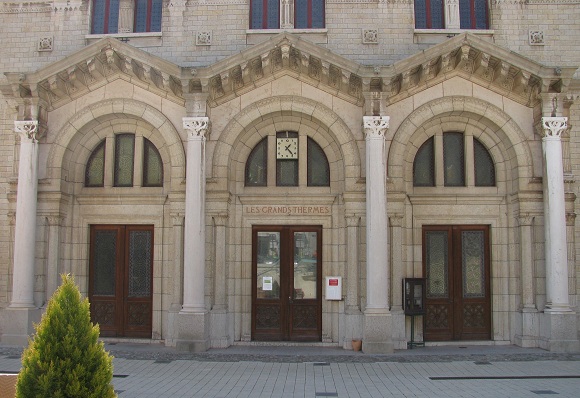
Today, a weekday, there was no competition for a seat on the patio of the restaurant of the town’s casino (in France, water-oriented resorts such as hot springs/spa towns are authorized to have a casino). I lunched there with Elisabeth Bertrand, director of the Chatel-Guyon tourist office. I faced out to the old thermal treatment center, les Grands Thermes (photo above), which closed in 2004, after nearly a century of use. The area didn’t seem abandoned, though in part it was, so much as waiting to be rediscovered.
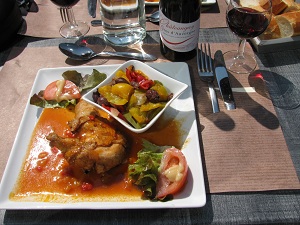
Over chicken supreme, vegetables and a red Châteaugay Cotes d’Auvergne wine, an appellation produced nearby, Mrs. Bertrand explained to me of the rise and decline and transformation of the town over the past 150 years. The general outline follows that described in Part II of this series, with the following specifics:
– 1817: the beginning of timid developments of a small hot springs resort;
– 1855: arrival of the train at Riom, four miles away;
– 1858: opening of the first major thermal center below the old town of Chatel-Guyon in the narrow valley where hot water, having vaporized from deep down in the water table of the plain, pushes up to the surface;
– 1878: a doctor and a banker join forces, setting the tone for the marriage of medicine and luxury that puts Chatel-Guyon on the map of places to come for the thermal cure. During this period, the phylloxera insect was destroying vines throughout France; though not directly related, the rise of the economy of hot springs in the region coincides with the decline of revenue from the vineyards.
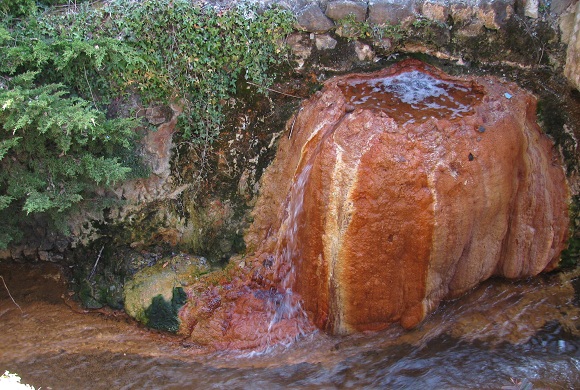
– 1890-1910: major developments including the construction, reconstruction and expansion of palatial hotels, the casino-theater complex, the central thermal center, and villas.
– 1912: Chatel-Guyon gets its own train station (now disaffected).
– 1919-1939: The good life continues between the wars, including the construction of another thermal bath and treatment center, the post office, and the Grand Hotel. The springs get additional medical certification particularly with new techniques to use the water to treat intestinal disorders;
– 1946-1970: With planes and more cars, increasingly mobile travelers are drawn to other vacation and resort destinations (the Riviera, foreign lands, etc.) while the medical use of hot springs here, as throughout France, becomes increasingly untethered from the notion of luxury, before losing any connection in the 1970s.
– 1970-2009: Taking the waters is no long associated with leisure and wealth but rather with the national health system’s willingness to provide for all or part of the costs of the 3-week cure. Among the clients sent to take the waters here in the 20th century are soldiers who were stationed in the French colonies and protectorates and sought treatment of intestinal disorders. By the 1960s those colonies and protectorates have gained independence from France, yet another element leading to the decline in the number of medical visitors at Chatel-Guyon from 22,000 in the late 1960s to 3500 in recent years.
What’s so special about this water?
The mineral content of the various hot springs throughout the Massif Central varies. Chatel-Guyon’s water is especially rich in magnesium, which makes it helpful in regulating intestinal transit, treat urinary problems, and healing intestinal wounds and inflammation. The presence of silicon leads it to be used for rheumatologic problems. Less important but also on the list of medical treatments for which doctors may prescribe taking the waters at Chatel-Guyon, is the presence of lithium along with the magnesium, which allows the mineral water to be prescribed for relieving stress, cramps and spasms.
To Americans and Brits, going to a designated faucet every morning for three weeks for a goblet of magnesium-heavy water or for a warm bath or other treatments may not sound very modern, or at least not influenced enough by the Japanese and Indian and Californian techniques that we now associate with spas, and some might prefer pills and other therapies, but there you have it, the Chatel-Guyon cure.
The more recent emphasis on the use of these springs for the treatment rheumatologic pain is expected to boost the number of medical visitors, according to Mrs. Bertrand, but the town isn’t betting the bank on its medical future alone. Instead, Chatel-Guyon’s growth, for this is not a town in decline but in growth, has (and presumably will) come from several other fronts.
– First, though Chatel-Guyon no longer has a direct train to Clermont-Ferrand (a train goes there from nearby Riom), this has become a bedroom community for those working in and around the regional capital. From 3500 residents in the 1970s, when most jobs were related to tourism and the hot springs, the town now as 6500 residents, even though it’s clear from the number and type of shops in town that many of those residents are spending their shopping money elsewhere. Still the numbers are enough to keep the schools and many services active.
– Second, as in all of these towns that developed thanks to their hot springs, there have been recent efforts to promote Chatel-Guyon as destination for that catch-all state of mind called “well-being” via contemporary spas. The 19th-century baths and treatment centers were always spas with a medical imprimatur, so the development of 21st-century spas emphasizing well-being rather than medicine makes good sense. For now the development of spas here and in the other hot spring towns that I visited on this trip are modest enough in size and investment that they’re largely for a local or sub-regional clientele, despite the occasional presence of a more distant visitor looking to enjoy two or three hours of soothing R&R. As far as the spas go, these aren’t international destinations, but as places to visit because of their history and architecture and natural landscape I find them fascinating for explorations off the beaten track.

– Third, more general tourism, particularly in summer, relative to their overall offering (hot springs, sports, nearby hiking, festivals).
Chatel-Guyon’s architectural heritage
A major sign of local efforts to project the town’s heritage into the future is the current renovation of the 400-seat Casino Theater through public funding and private donations. The theater, once one of the jewels of the Chateau-Guyon, was first completed in 1900 and then expanded in 1910. It’s due to reopen in 2014. Owned by the town, it is expected to earn itself a place on the festival circuit map in the region.
In discussing all this with Mrs. Bertrand, I remarked how different the role of government is in a town like this compared with a similar-sized town (or, likely, any town) in the United States. “For us,” she said, “inteventionism,” meaning the role of the government in the economic life of the town, “isn’t simply the government giving something away.” She spoke of it more in terms of making consensus decisions. “[Interventionism] has a relationship with our roots.” Americans would invariably see this as socialsm. Yet, as noted in Part II of this report, many old spa town lean right at the voting booth, though there’s no fast rule.
All of the spa towns that I visited on this trip were trying to answer the question as to what to do with their architectural heritage now that economic and cultural winds have blown away the original clients of that architecture. Chatel-Guyon, for instance, once had 70 hotels, including a number of luxury establishment. Currently, only 14 of those buildings operate as hotels, with the highest currently rated with three (out of five) stars (e.g. Splendid, Bellevue, Omental Thermalia).
Early in the 20th century, 28 springs were being exploited at Chatel-Guyon; in 1970, fourteen; now just five. You can see some of them, disaffected or closed off from the public, as you walk along the grounds of the thermal park. The luxury hotels of yesterday have been transformed into apartment buildings, their grand entrances, lobbies and ballrooms a bit forlorn without any doorman outside or fancily coiffed women walking with umbrellas on a sunny day. But I wouldn’t want this to sound like a sad portrait for this is indeed a healthy, living town. The valley of the hot springs and surrounding hotels/apartment buildings and villas makes for a pretty stroll.
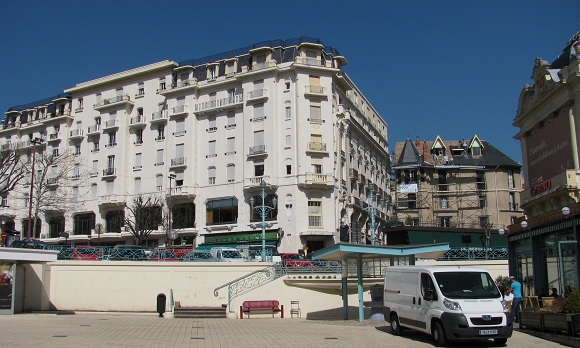
The new thermal baths and treatment center of the 1980s, up the park from the casino, isn’t very attractive from the outside, but the old thermal center, the Grands Thermes, that I faced while having lunch is a treat for the historic-minded eye. Built 1904-1908, around the same time as other elements of the “thermal park,” as this part of the valley is called, the Grands Termes closed in 2004 and was purchased by the town five years later for a symbolic euro. There is as yet no consensus (i.e. viable project) as to what to do with it. However, its situation beside the casino and theater and its interior lobby are certainly promising.
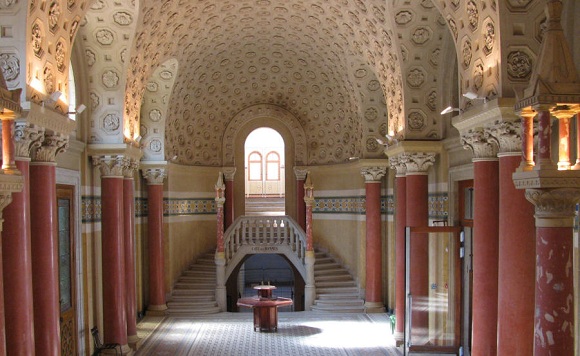
The architectural heritage of these hot spring towns is part of what makes them so appealing to me. In the view above, taken from the entrance to the men’s wing of the Grands Thermes, you see the arched coffered ceiling, the red marble columns, the central table where those taking the cure would sit to write letters or to read the day’s paper, and the horseshoe staircase leading to the women’s wings. There are handsome details in the mosaic work throughout.
Unfortunately, the Grands Thermes can only be visited on Sundays from 4 to 7pm during the April-October “thermal cure” season. Once the theater has reopened in 2014 some bright and viable (or at least not too heavily subsidized) proposals will likely reach the mayor’s desk. The central space is simply too attractive to keep closed.
Coming up with a new use for the dozens of treatment rooms will be more difficult. Here’s a view of one of the treatment rooms with its ancient installations, in use until 2004.

A sunny walk-about in Chatel-Guyon eventually leads up the hill past several villas from the early 1900s, such at the villa “Les Jeannettes” (1908)…
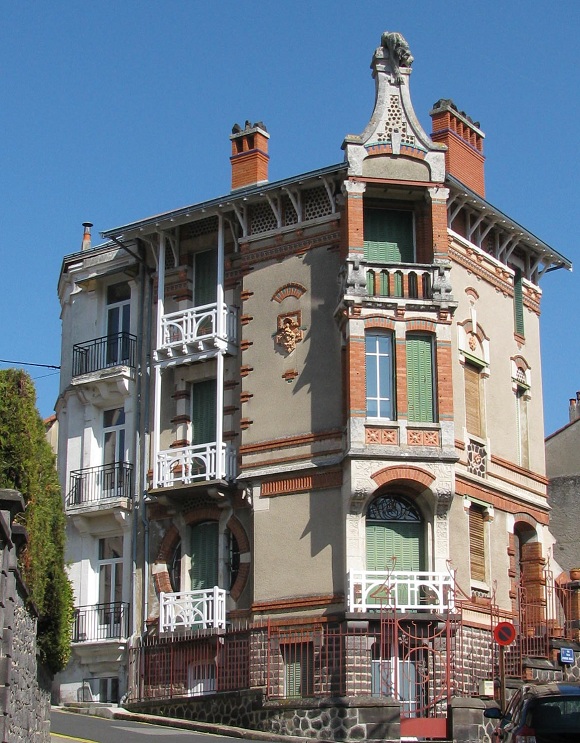
… and to the site where Guy’s “chatel” once stood. There’s a milky late-afternoon light as I look out over the valley of the hot springs and beyond to the entrance to the volcanic park.
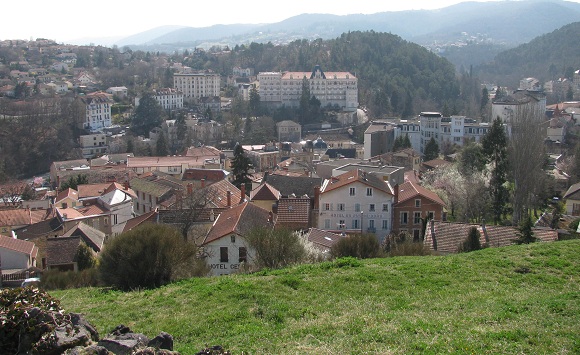
But I left Chatel-Guyon headed in the opposite direction, out into the plain, where Guy would watch for trouble and where I would spend an trouble-free night at the 5-star Chateau La Canière.
© 2012, Gary Lee Kraut
Other articles in this “Five Days in Auvergne” series:
Part I: From Paris to Clermont-Ferrand
Part II: An Introduction to Spa Towns and Hot Springs By Way of Royat
Part IV: Chateau La Canière, a luxury hotel
Part V: Mont Dore, Saint Nectaire, Chaudes-Aigues and Yu.

